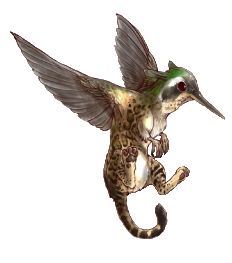Kolibtus or The Humming-cat
Basic Information
Anatomy
Kolibtus are six limbed creatures like all Griffon species. They are the smallest of the Griffons, typically only weighing a couple of pounds and being about as big as a Chihuahua. They typically have a striped or spotted body that come in light brown or orangish colors, and have colorful heads and wings that come in greens, blues, and reds. They have small talons acting as their front feat and small cat like feet acting as their back legs. They have a small needle-nose like beak that they use to feed.
Genetics and Reproduction
This species typically has a gestation period of two weeks before laying an egg.
Growth Rate & Stages
Humming-cats will hatch after about fifteen days and are typically old enough to leave the nest after about a month and are fully grown after around four months.
Ecology and Habitats
This species lives in tropical environments in the wild with lots of access to flowers, fruits, and small insects. They typically are found around sources of fresh water as this is where the most plants are found in a small area.
Dietary Needs and Habits
The best food for Kolibtus is sugar rich nectar from flowers, though they will also eat small insects and small fruits and berries.
Biological Cycle
They can live around 8-12 years before passing away, typically when their fast beating hearts give out.
Additional Information
Domestication
This species has been domesticated and are typically owned by the rich elite. They can be very expensive as it is difficult to get them to breed and they are in high demand to do their looks and size. Despite being so small, this species is very aggressive and territorial. If trained well can make for a great pet that will defend their owner, and even can be familiars for some spell casters if the bond is strong enough.
Perception and Sensory Capabilities
Kolibtus have average vision and hearing, but an excellent sense of smell that they use to find flowers.
Genetic Ancestor(s)
Scientific Name
Gryphus Kolibtus
Geographic Distribution




Comments